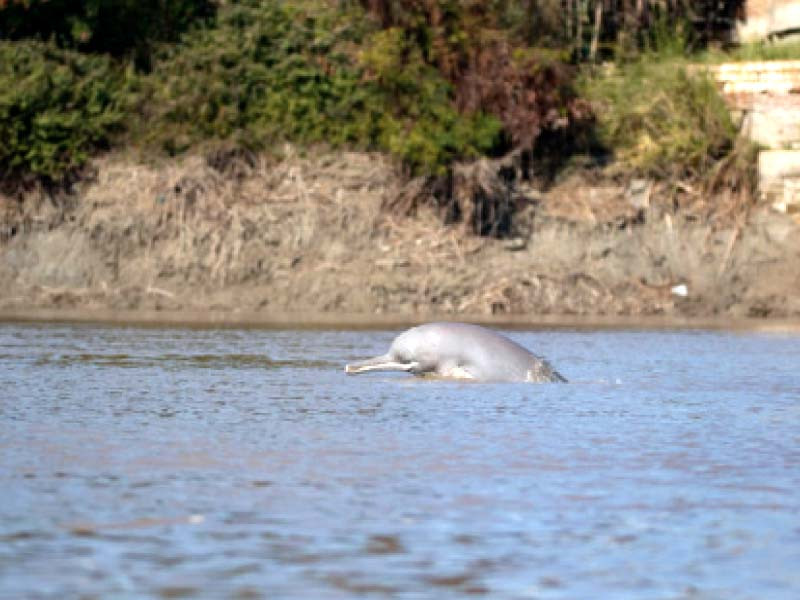
A two-decade-long research has concluded that endangered Indus River dolphin and Ganges River dolphin, believed to be the same species, are distinct enough to be categorised as two separate species. The research, however, is to be validated by the Society for Marine Mammalogy's Committee on Taxonomy in the coming few months.
Once the research, published in peer-reviewed journal Marine Mammal Science, is validated, the number of dolphin species in the world will be raised to six.
The research concludes that dolphins in the Indus River and Ganges-Brahmaputra Rivers are sufficiently distinct to be classified as species in their own right.
The work, which took 20 years to complete, was led by Dr Gill Braulik of the Sea Mammal Research Unit at the University of St Andrews.
Read: Man arrested after mishandled Indus dolphin dies
Dr Braulik travelled across India and Pakistan to gather data for the study. His endeavours included searching for dolphin skulls to measure.
The research shows that dolphins in the two rivers have different number of teeth, coloration, growth patterns and skull shapes, as well as clear genetic differences.
"Recognising the differences between Indus and Ganges River dolphins is extremely important as only a few thousand individuals from each pool remain," said Dr Braulik. "They have long been regarded as two of the world's most threatened mammals. My hope is that our findings will bring the much-needed attention to these remarkable animals, which will help prevent them from sliding towards extinction."
Commenting on the matter, Sindh Wildlife Department chief conservator Javed Ahmed Mahar said it was encouraging to note that the fruits of long-term research were near harvest.
The research involved a long-term collaboration between the University of St Andrews World Wildlife Fund-Pakistan, Patna University in India, the Southwest Fisheries Science Centre of the National Oceanic and Atmospheric Administration in the United States of America and researchers in South Asia.
Near extinction
Indus and Ganges River dolphins are often referred to as blind dolphins because they live in naturally muddy rivers and after millions of years of evolution have lost their eyesight, instead of which they rely on a sophisticated sonar or echolocation system to navigate their way and catch prey.
Both species are threatened by accidental entanglement and drowning in fishing nets, by the construction of hydropower dams and irrigation barrages and the polluting of waterways, and are listed as endangered in the International Union for Conservation of Nature's Red List.
According to Dr Braulik, "The rapid decline and extinction of Yangtze River dolphin this century was a very clear warning- we need to act quickly to protect the remaining species of river dolphins, including those in Indus and Ganges, all of which are seriously threatened.
"The freshwater systems they inhabit must be managed with biodiversity as a top priority," he emphasised.
Also read: ‘Development along Indus imperils blind dolphins’
Recovery
The population of Ganges River dolphins is estimated at around 3,500 to 4,500 across Bangladesh, India and Nepal and is still declining. Meanwhile, Indus River dolphins have achieved an impressive recovery over the last 20 years, with numbers going up from approximately 1,200 in 2001 to more than 1,900 in 2017, despite huge challenges including an 80 per cent decline in the extent of their range. While almost all Indus River dolphins are found in Pakistan, a tiny population still survives in Beas - a tributary of the Indus - in India.
"The recovery Indus River dolphin in Pakistan is due to the decades of dedicated on-the-ground work by authorities and communities and shows what is possible when we work together to conserve them," according to WWF-P's river dolphin initiative Asia coordinator Dr Uzma Khan. "Serious challenges are still faced by this incredible species and all other river dolphin populations, but we can save them - and by doing so we'll save so much more since hundreds of millions of people and countless other species depend on the health of river dolphin," she said.
Published in The Express Tribune, March 31st, 2021.



1725443747-0/Untitled-design-(5)1725443747-0-165x106.webp)

















COMMENTS (1)
Comments are moderated and generally will be posted if they are on-topic and not abusive.
For more information, please see our Comments FAQ